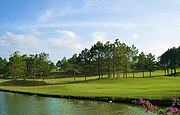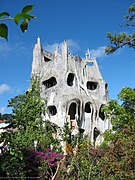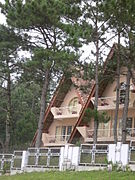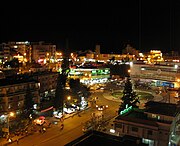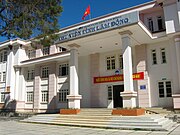Da Lat
You can help expand this article with text translated from the corresponding article in Vietnamese. (April 2021) Click [show] for important translation instructions.
|
Da Lat
Thành phố Đà Lạt | |
|---|---|
UTC+7 | |
| Climate | Cwb |
| Website | https://dalat.lamdong.gov.vn/ |
Da Lat or Dalat
Da Lat's specific sights are
Residents and tourists have said that Da Lat has all four seasons in one day: spring in the morning, summer at noon, autumn in the afternoon and winter at night, from the sunset to the sunrise.
Da Lat is also known as an area for scientific research in the fields of biotechnology[5] and nuclear physics.[6]
With its year-round cool weather, Da Lat supplies huge amounts of temperate agriculture products for all over Vietnam, for example:
Da Lat is known regionally for avocado ice-cream, bánh tráng nướng, and its large garment market, with a broad selection of cool-weather clothing.
Name

According to some sources, the name is derived from the acronym of the Latin phrase 'Dat Aliis Laetitiam Aliis Temperiem' ("It Gives Pleasure to Some, Freshness to Others"), which the French colonial government used in their official emblem of Da Lat. In reality, however, the name Đà Lạt is derived from the language of the local ethnic group
History


French era

During the 1890s, explorers in the area (including the noted bacteriologist Alexandre Yersin, protégé of the renowned French chemist Louis Pasteur), which was then part of the French colony of Cochinchina, asked the French governor-general, Paul Doumer, to create a resort center in the highlands, and the governor agreed. The original intended site for the hill station was Dankia, but Étienne Tardif, a member of the road-building expedition of 1898–99, proposed the current site instead. In 1907, the first hotel was built. Urban planning was carried out by Ernest Hébrard.[8]

Many Europeans used to travel up to Da Lat to escape the heat of the lower coastal areas and Mekong delta.
The French endowed the city with villas and boulevards, and its Swiss charms remain today. Hébrard included the requisite health complex, golf course, parks, schools, and homes but no industry. The legacy of boarding schools where children from the whole of Indochina were taught by French priests, nuns, and
In the 1920s and 1930s, there were ideas of making Da Lat the 'summer capital', 'administrative capital', and 'federal capital' of French Indochina. During the World War II, Governor-general Jean Decoux (r. 1940–1945) supported this project.[9]
South Vietnamese era
The South Vietnamese National Military Academy graduated its first class of future leaders in 1950. There was also an aviation school at Cam Ly Airport.
In the mid-1950s, the Vietnamese Scout Association established their national training grounds at Da Lat.
The only major involvement Da Lat had during the Vietnam War was during the 1968 Tet Offensive. Fierce battles raged from January 31 to February 9, 1968. Most of the fighting took place between the South Vietnamese/American MP units stationed in Da Lat and the Việt Cộng (VC) forces. Defeats and victories alternated between the two during the sporadic-yet-intense battles.
Communist Vietnam

South Vietnam eventually fell under communist rule and was merged with the
During the communist era of Vietnam (the Socialist Republic of Vietnam), places like Da Lat as well as Hoi An and Da Nang were regularly regarded as amongst the most romantic tourist places in Vietnam.[10] Da Lat has also become the hub of nuclear research and biotechnology.
Geography
Da Lat is located 1,500 m (4,900 ft) above sea level on the
Geology
Da Lat is a source area for pyroxene from meteorites from the Australasian strewnfield.[11]
Administrative
Da Lat is divided into 11 wards numbered from 1 to 11, and 4 communes: Tà Nung, Xuân Trường, Xuân Thọ and Trạm Hành.[12]
Climate
| Da Lat | ||||||||||||||||||||||||||||||||||||||||||||||||||||||||||||
|---|---|---|---|---|---|---|---|---|---|---|---|---|---|---|---|---|---|---|---|---|---|---|---|---|---|---|---|---|---|---|---|---|---|---|---|---|---|---|---|---|---|---|---|---|---|---|---|---|---|---|---|---|---|---|---|---|---|---|---|---|
| Climate chart (explanation) | ||||||||||||||||||||||||||||||||||||||||||||||||||||||||||||
| ||||||||||||||||||||||||||||||||||||||||||||||||||||||||||||
| ||||||||||||||||||||||||||||||||||||||||||||||||||||||||||||
Da Lat features a
Da Lat's year-round temperate weather, standing in contrast to central & southern Vietnam's otherwise-tropical climate, has led it to be nicknamed the “City of Eternal Spring”.[13] The average temperature is 14 to 23 °C (57 to 73 °F). The highest temperature ever in Da Lat was 32.1 °C (89.8 °F), and the lowest was −0.6 °C (30.9 °F).[14] Mist covers the adjoining valleys almost year-round. Its temperate climate also makes it ideal for agriculture. Indeed, Da Lat is renowned for its orchids, roses, vegetables, and fruits. There are nascent wine-making and flower-growing industries in the region.
There are two separate seasons in Da Lat. The rainy season lasts from May to October, and the dry season lasts from November through April of the next year. The average annual precipitation is 1,750 mm.[15][16]
| Climate data for Da Lat | |||||||||||||
|---|---|---|---|---|---|---|---|---|---|---|---|---|---|
| Month | Jan | Feb | Mar | Apr | May | Jun | Jul | Aug | Sep | Oct | Nov | Dec | Year |
| Record high °C (°F) | 30.0 (86.0) |
31.0 (87.8) |
31.5 (88.7) |
32.1 (89.8) |
30.6 (87.1) |
30.5 (86.9) |
32.1 (89.8) |
30.0 (86.0) |
30.2 (86.4) |
30.0 (86.0) |
29.2 (84.6) |
29.4 (84.9) |
32.1 (89.8) |
| Mean daily maximum °C (°F) | 22.3 (72.1) |
23.9 (75.0) |
25.1 (77.2) |
25.3 (77.5) |
24.7 (76.5) |
23.6 (74.5) |
23.0 (73.4) |
22.7 (72.9) |
22.9 (73.2) |
22.8 (73.0) |
21.7 (71.1) |
21.4 (70.5) |
23.3 (73.9) |
| Daily mean °C (°F) | 15.9 (60.6) |
16.9 (62.4) |
18.1 (64.6) |
19.0 (66.2) |
19.5 (67.1) |
19.2 (66.6) |
18.8 (65.8) |
18.6 (65.5) |
18.5 (65.3) |
18.2 (64.8) |
17.5 (63.5) |
16.4 (61.5) |
18.0 (64.4) |
| Mean daily minimum °C (°F) | 11.7 (53.1) |
11.9 (53.4) |
13.0 (55.4) |
14.7 (58.5) |
16.2 (61.2) |
16.4 (61.5) |
16.2 (61.2) |
16.2 (61.2) |
16.0 (60.8) |
15.3 (59.5) |
14.6 (58.3) |
13.2 (55.8) |
14.6 (58.3) |
| Record low °C (°F) | −0.1 (31.8) |
−0.6 (30.9) |
4.2 (39.6) |
4.0 (39.2) |
10.0 (50.0) |
10.9 (51.6) |
10.4 (50.7) |
10.6 (51.1) |
10.0 (50.0) |
8.1 (46.6) |
4.4 (39.9) |
2.6 (36.7) |
−0.6 (30.9) |
| Average rainfall mm (inches) | 9.1 (0.36) |
20.5 (0.81) |
64.1 (2.52) |
170.3 (6.70) |
212.3 (8.36) |
203.5 (8.01) |
232.7 (9.16) |
238.3 (9.38) |
283.4 (11.16) |
244.7 (9.63) |
93.5 (3.68) |
36.2 (1.43) |
1,808.6 (71.2) |
| Average rainy days | 2.2 | 2.5 | 5.8 | 12.8 | 20.5 | 21.2 | 23.8 | 23.1 | 24.0 | 20.0 | 11.5 | 5.9 | 176.8 |
| Average relative humidity (%)
|
81.2 | 77.7 | 78.1 | 83.3 | 87.2 | 88.8 | 89.7 | 90.4 | 90.2 | 88.6 | 85.4 | 84.2 | 85.5 |
| Mean monthly sunshine hours | 237.4 | 231.1 | 240.2 | 199.2 | 195.5 | 150.3 | 146.9 | 134.4 | 126.5 | 139.8 | 168.5 | 198.7 | 2,147.8 |
| Source 1: Địa chí Đà Lạt (extremes 1918–1940, and 1964–1998)[14] | |||||||||||||
| Source 2: Vietnam Institute for Building Science and Technology,[17] The Yearbook of Indochina (1932-1933 and 1950-1951)[18][19] | |||||||||||||
Education
- Dalat University (Trường Đại học Đà Lạt)
- Yersin University (Trường Đại học Yersin Đà Lạt)
- The Pedagogical College of Da Lat (Trường Cao đẳng Sư phạm Đà Lạt)
- Ho Chi Minh City University of Architecture – Đà Lạt Campus (Trường Đại học Kiến trúc TP.HCM – Phân hiệu Đà Lạt)
Architecture
It has been suggested that this section be split out into another article titled Architecture of Da Lat. (Discuss) (April 2019) |
The
Of particular note is the unconventional architecture of the

Da Lat is also well known for a series of three Mansions of the Vietnamese Last Emperor. The First Mansion was built in 1940 by the French millionaire Robert Clément Bourgery and was bought by Emperor
Festivals
- Dalat Flower Festival (Festival Hoa Đà Lạt)
- Dalat Tea Culture Week (Tuần lễ văn hóa Trà Đà Lạt)
- Cherry Blossom Festival (Lễ hội Hoa Anh Đào)
- "Đồi cỏ hồng" Festival
- Rain Festival (Lễ hội Mưa)
- Gong Festival (Lễ hội Cồng chiêng)
Tourism

Da Lat is one of the famous tourist cities of Vietnam which was included in the list of Asia's most overlooked places by CNN in 2017. [29] Da Lat attracts both domestic tourists and foreign tourists, with more than 1,500,000 tourists and about 300,000 foreign tourists visiting the city every year. It is also the most favorite honeymoon location in Vietnam.[30]
Hoa Binh Area is in the center downtown of Da Lat and attracts numerous visitors. Some popular sites located in the Hoa Binh Area are Coi Xay Gio bakery, Lien Hoa bakery, Windmills coffeehouse and Tung coffeehouse. Coi Xay Gio was known as a perfect selfie spot thanks to its remarkable yellow wall, though in 2021 the wall was repainted to discourage selfies due to danger from road vehicles.[31]
Popular tourist places
- Xuan Huong Lake
- Lam Vien Square
- Hoa Binh Walking Town (Hoa Binh Area)
- The Pedagogical College of Da Lat
- Dalat Center Market
- Da Lat Railway Station
- The Palace of Bao Dai King
- Clay Tunnel of Da Lat
- Tuyen Lam Lake
- Smurf Village (Làng Xì Trum)
- Truc Lam Monastery
- Hang Nga guesthouse
- Linh Sơn Pagoda
- Dalat Flowers Garden
- Dalat Cathedral (Chicken Church)
- Domaine de Marie
- Valley of Love
- Dreamlike Hill (Mộng Mơ Hill)
- Langbiang Peak
- Prenn Waterfall
- Golden Stream Lake (Suối Vàng)
- The Maze Bar
- Vuon Yen Coffee
- Vinh Tien Tea & Wine Company
- Vu Thi Village
- Dalat Heaven Gate
- Linh Quy Phap An Pagoda
- Infinite Lake (Vô Cực Lake)
- Zoodoo Garden
- Flowers Garden and Coffee (F. Garden)
- Minions Themed Village
Gallery
-
A golf course in Da Lat
-
Golden Valley in the morning mist
-
Hang Nga guesthouse
-
A villa in Dalat's pine forest
-
A hydrangea flower in Da Lat
-
Coffee terrace near Da Lat
-
Artichoke tea, a product of Dalat
-
Da Lat Center Market during nighttime
-
View of Da Lat
-
Lam Dong Library
-
Dalat Teacher's College
See also
- Da Lat–Thap Cham Railway
- Dalat Palace Hotel
References
- ^ "The only city in Vietnam without traffic lights". www.viettravelmagazine.com.
- ^ "Dalat | Vietnam Tourism". Vietnam National Administration of Tourism. Archived from the original on 2020-04-06.
- ^ "Da Lat - The city you should not miss in Vietnam". vietnameasyrider.com.
- ^ "See, Do & Eat Guide to Dalat – Vietnam's City of Eternal Spring". highlandsporttravel.com.
- ^ "Creating Technological Capability and Tourism Potential". Retrieved 2022-02-19.
- ^ "Vietnam resort town concerned nuclear reactor could hit tourism". Thanh Nien Daily. 2014-03-31. Archived from the original on 2022-02-19. Retrieved 2022-02-19.
- ^ "Dalat Flowers : The Development of Flower Industry". Retrieved 2022-02-19.
- ^ Crossette, Barbarạ The Great Hill Stations of Asia. Boulder, CO: Westview Press, 1998. pp 207-219.
- ^ Jennings (2011), p. 228–230.
- ^ VnExpress. "Da Lat, Hoi An among Vietnam's most romantic places for Valentine's Day". VnExpress International. Retrieved 2022-02-19.
- .
- ^ Da Lat Travel Guide VietnamTravelGo
- ISBN 1-74059-677-3, pp. 290–305.
- ^ a b "KHÍ HẬU" (in Vietnamese). City Of Da Lat. Archived from the original on 2 March 2013. Retrieved 26 January 2015.
- ^ "Da Lat". Encyclopædia Britannica. 2012. Retrieved 22 September 2012.
- ^ "Nature". www.lamdong.gov.vn. Retrieved 2020-07-22.
- ^ "Vietnam Institute for Building Science and Technology" (PDF).
- ^ The Yearbook of Indochina (1932-1933)
- ^ Archived copy Archived 10 May 2021 at the Wayback Machine
- ^ Samantha Coomber (1 January 2008). "Paradise by the Dashboard Light". Air Canada enroute. Archived from the original on 28 February 2012. Retrieved 22 September 2012.
- ^ Minh Thu (2009-02-22). "Little Paris charms visitors". Asia News Network. Archived from the original on 2011-06-15. Retrieved 2010-07-16.
{{cite web}}: CS1 maint: unfit URL (link) - ISBN 978-1-903471-31-9. Retrieved 2010-07-28.
- ^ "Dalat (Da Lat)". Saigon Vietnam (in French). Retrieved 2015-11-07.
- ^ Fida Wild (2009–2012). "The Crazy House". Unusual Travel Destinations. Unusual-Travel-Destinations.com. Archived from the original on 26 June 2012. Retrieved 24 September 2012.
- ^ Madame Hang Nga's Crazy House. Maggie Huff-Rousselle. The Globe and Mail. Archived July 7, 2011, at the Wayback Machine
- ^ "Da Lat 'Crazy House' joins bizarre global list". Vietnam Plus. Vietnam News Agency (VNA). 22 September 2009. Retrieved 24 September 2012.
- ^ "Da Lat's "Crazy House"". Archived from the original on June 12, 2008.
- ^ "Các Dinh I, II, III". www.lamdong.gov.vn. Archived from the original on 2019-02-12. Retrieved 2019-02-10.
- ^ "Asia's overlooked places: 9 for your travel list". CNN. Retrieved 21 January 2019.
- ^ "DALAT TOURIST INFORMATION CENTER". Retrieved 2019-04-16.
- ^ "This yellow wall is the hottest check-in location of Da Lat right now (Vietnamese)". Kenh14.
- Jennings, Eric T. (2011). Imperial Heights: Dalat and the Making and Undoing of French Indochina. University of California Press. ISBN 9780520948440.
External links
 Media related to Da Lat at Wikimedia Commons
Media related to Da Lat at Wikimedia Commons Da Lat travel guide from Wikivoyage
Da Lat travel guide from Wikivoyage- Official website of the provincial government (Vietnamese)


